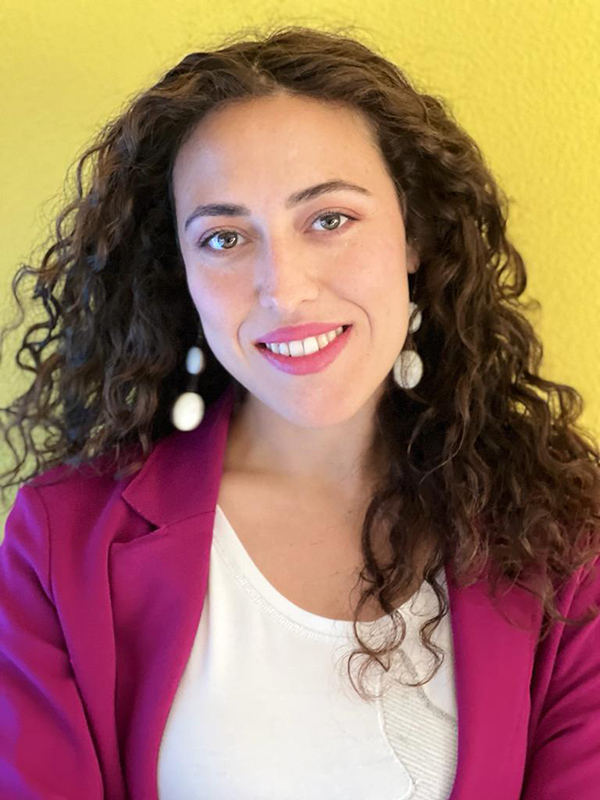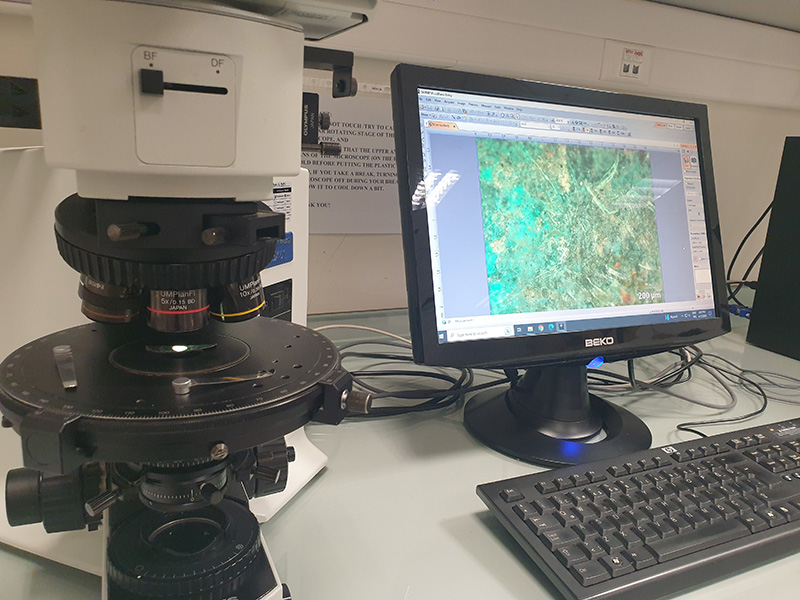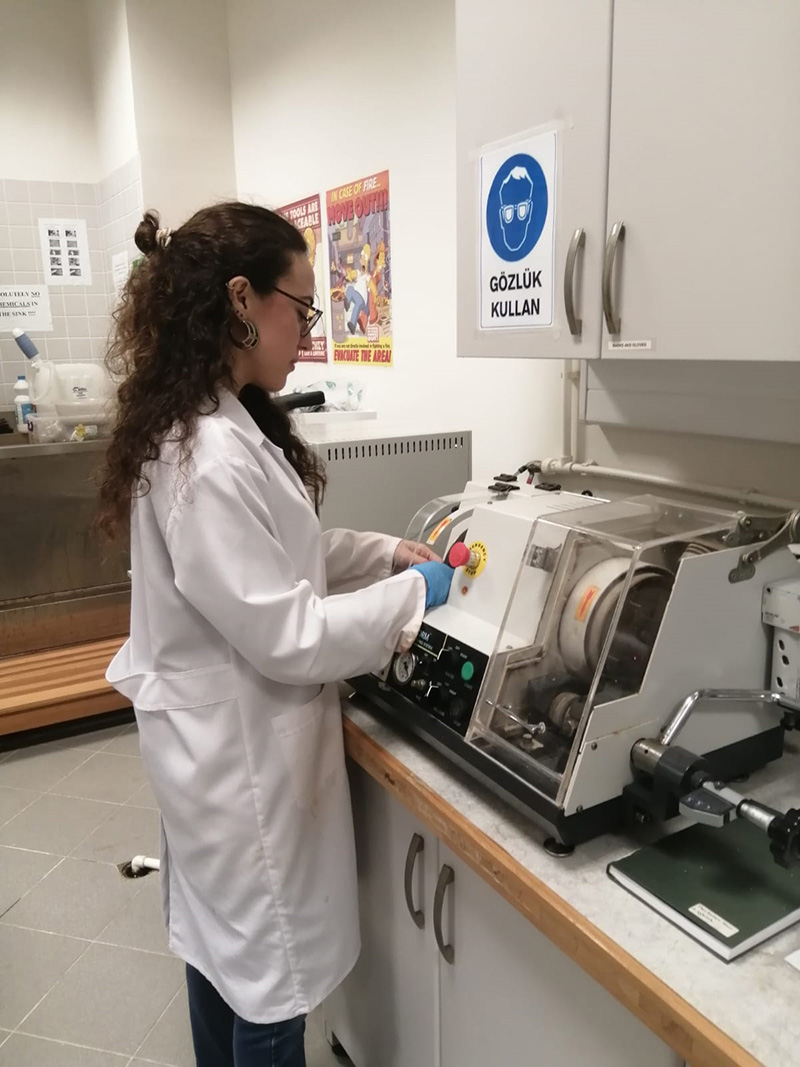
Arkeometalurjik analizler konusunda uzmanlaşmış bir arkeolog ve Koç Üniversitesi Arkeoloji Bölümü’nden doktora derecesine sahip olan Dr. Alberghina’nın araştırmaları, Batı Anadolu’da gelişen MÖ 2. binyıl metal endüstrilerinin artzamanlı ve bölgesel olarak incelenmesine ve daha spesifik olarak Kaymakçı Kalesi’nden elde edilen Geç Tunç Çağı metal topluluğunun metalografik ve bileşimsel analizlerine odaklanmıştır. Türkiye’de uzun yıllar saha arkeoloğu olarak çalışmış olan Dr.Alberghina, hem batı hem de güneydoğu bölgelerinde Tunç Çağı’ndan Klasik Çağ’a kadar uzanan yerleşim yerlerinde kazılar yapmıştır. Ayrıca günümüz Manisa ilinde, yerel beslenme biçimleri ve ortak yaşam üzerine arkeolojik ve antropolojik verileri birleştiren disiplinlerarası bir projenin parçası olarak etnografik araştırmalar yürütmüştür. Daha geniş anlamda, araştırma ilgi alanları, ritüelistik davranış ve antik metalürjik üretimin duyusal yönleri merceklerinden de gözlemlenen, maddiyat ve teknolojinin karmaşık semantiği etrafında dönmektedir. ANAMED doktora sonrası araştırmacısı olarak, mevcut araştırmasını genişleterek, satın alma modellerini analiz etmek ve bunları MÖ 2. binyıl Batı Anadolu’sunda ticaret, kültürel alışveriş ve ekonomik karşılıklı bağımlılık üzerine daha geniş bir tartışmaya bağlamak için Kaymakçı’dan bakır alaşımlı örneklerin izotopik imzalarını inceleyecektir.
Metal Technology and Exchange in Middle and Late Bronze Age Western Anatolia: Reconstructing Intra– and Interregional Networks of Procurement through Isotopic Analyses
Dalila M. Alberghina
During the 2022–2023 academic year, I was awarded a nine-month Postdoctoral Fellowship at ANAMED. This period has been crucial to further elaborate and process the data produced during the last years of my research, as well as to advance the publication of the results of my doctoral dissertation. Furthermore, the networks of friendship and collaboration established during this period have fostered both new academic initiatives and venues for personal growth, for which I am extremely grateful.
The title of my project revolved around a specific regional and chronological setting, that of western Anatolia in the second millennium BCE, and a specific class of material evidence, that of metal artifacts and tools related to metallurgical production. As circumscribed as it might sound, this area of research inserts itself into a broad network of methodological and theoretical issues.
On one hand, the study of western Anatolian metallurgical industries developing throughout the Middle and Late Bronze Age (hereafter MBA and LBA) calls for a wider re-assessment of the socio-economic and cultural phenomena characterizing the region in these crucial phases. On the other, the adoption of archaeometric methods of analysis on metal artifacts demands reflection on the interplay of concepts such as technology, craft, specialized production, transfer of knowledge, and sensory skills.[1] Both these macro-areas have been investigated during the first months of my fellowship, resulting in two different single-authored contributions and two co-authored papers currently in the submission process.[2] Moreover, crucial steps have been made to add new archaeometric datasets to the ones already available for the LBA metal corpus of the site of Kaymakçı (modern-day province of Manisa[3]).
The main questions prompting my past and current research stem from a few pivotal premises, first and foremost the importance of archaeometallurgical studies to investigate disparate but complementary aspects of the cultural, socio-economic, and political milieus of Anatolian Bronze Age societies. The developments in metal production characterizing Anatolian cultures (here intended in terms of expansion of procurement networks, growth in the production volume, and technological advancements) have justly been seen as both a catalyst and a result of complementary phenomena of socio-economic complexity and cultural exchange. Research on western Anatolian metallurgy during the third millennium BCE (i.e., the Early Bronze Age phase) has consistently provided data pointing to the presence of regional exploitation of metal sources and long-distance trade of raw materials and finished products, as well as evidence for technological experimentation and cultural exchange with neighboring regions.[4] However, studies on regional metallurgical horizons dating to the second millennium BCE have focused only on a few, isolated sites’ assemblages.[5] The paucity of data is regrettable when considering the pivotal role played by Anatolian metal sources (especially for silver, gold, and copper) in the complex trade networks established at the onset of the MBA and developing throughout the LBA.
As a macro-region that witnessed important phenomena of political instability, contacts with the Aegean and the Anatolian spheres, and autonomous re-interpretation of local and exogenous cultural traits, western Anatolia represents a great area to assess in which ways manufacturing strategies, local production, exploitation of sources, and exchange of raw and finished metal products responded and adapted to contemporary cultural and socio-economic phenomena. In this regard, and in tandem with typological studies, archaeometric research plays a major role in providing data on alloying strategies (via compositional analyses), manufacturing practices (via metallographic analyses), localities of primary and secondary metallurgical production (through identification and examination of production wastes and tools), and intra- and inter-regional trade (via trace element and isotopic analyses).
I have approached the study of the metal corpus retrieved at the LBA citadel of Kaymakçı following this methodological categorization. While compositional and microstructural investigations have already been conducted using the equipment available at the Koç University Surface Science and Technology Center (KUYTAM), the current goal is to explore issues of copper provenance to assess diachronic and regional patterns of similarity and difference between the Kaymakçı dataset and those available for other contemporary sites in western Anatolia and beyond. In the last months, I had the opportunity to use the equipment available at the ARHA Laboratory of Koç University to conduct additional research in preparation for planned provenance analyses targeting copper-alloyed specimens retrieved at Kaymakçı. Fully preserved and fragmentary metal tools (i.e., mainly awls and drills) were observed using Polarized Light Microscopy for the identification of surface use-wear traces and marks. This was approached more as a trial, as use-wear analyses on metal specimens is still a relatively underdeveloped branch of archaeometallurgical research.[6]


Moreover, specimens available for invasive investigations were selected and sampled in preparation for trace-element and lead-isotope analyses. The aim was to include artifacts representative of the main alloy groups identified (i.e., arsenical coppers, tin bronzes, and ternary alloys) and dating to all main local phases of occupation (spanning the seventeenth to fourteenth centuries BCE).

Processed archaeometallurgical data were presented at the 13th International Congress on the Archaeology of the Ancient Near East (ICAANE), which took place in Copenhagen during the last week of May.
Prior to that, the collaboration with other postdoctoral and senior fellows, whose research interests revolve around the study of Anatolian Bronze Age and Early Iron Age cultures, produced an interesting workshop organized on April 18th, 2023. Entitled “Materialized Politics and Embodied Symbols. Foundation and Re-foundation in Hittite Anatolia,” this hybrid roundtable brought together scholars from universities and research institutions around Turkey and Italy with the aim to discuss new textual and archaeological data from some of the most important LBA sites of central Anatolia. This was a great occasion to prompt academic dialogue among established scholars and early career researchers and to foster dialogue between specialists working in different regions of Turkey.
To sum up, the diverse and rich research environment provided by ANAMED has not only provided an ideal setting for my own research, but it has also played a pivotal role in fostering old and new relationships with scholars working on the archaeology and history of ancient Anatolian civilizations. My gratitude goes to the entire ANAMED staff for providing us with this opportunity, as well as to Prof. Christopher H. Roosevelt, Prof. Christina Luke, and the team of the Kaymakçı Archaeological Project for their support in conducting past, present, and future research on the Kaymakçı metal corpus.
References
Alberghina, Dalila M. “Between the Hammer and the Anvil? An Overview on Western Anatolian Metallurgy during the 2nd Millennium BCE.” In Proceedings of the WANAT Symposium, edited by Peter Pavúk, Magda Pieniążek, and Christopher H. Roosevelt (Istanbul: Koç University Press, forthcoming).
Begemann, Friedrich, Sigrid Schmitt-Strecker, and Ernst Pernicka. “On the Composition and Provenance of Metal Finds from Beşiktepe (Troia).” In Troia and the Troad—Scientific Approaches, edited by Günther A. Wagner, Ernst Pernicka, and Hans-Peter Uerpmann, 173–201. Heidelberg: Springer Verlag, 2023.
Dolfini, Andrea, and Rachel J. Crellin. “Metalwork Wear Analysis: The Loss of Innocence.” Journal of Archaeological Science 66 (2016): 78–87.
Erkanal-Öktü, Armağan, and Hayat Erkanal. “Neue Forschungen im Vorgeschichtlichen Mittelwestanatolien. Bakla Tepe, Liman Tepe, Çeşme-Bağlararası und Panaztepe.” In Anatolien-Brücke der Kulturen. Aktuelle Forschungen und Perspektiven in den Deutsch-Türkischen Altertumswissenschaften, edited by Ünsal Yalçin and Hand-Dieter Bienert, 185–204. Bonn: Boch, 2015.
Ingold, Tim. “Beyond Art and Technology: the Anthropology of Skill.” In Anthropological Perspectives on Technology, edited by Michael B. Schiffer, 17–31. Albuquerque: UNM Press, 2001.
Keskin, Levent. “A Survey of West Anatolia Metallurgy Prior to Middle Bronze Age (2000 BC).” The International Journal of Social Studies and Humanities 4, no. 6 (2016): 187–95.
Mehofer, Mathias. “Metallurgy during the Chalcolithic and the Beginning of the Early Bronze Age in Western Anatolia.” In Western Anatolia before Troy. Proto-Urbanisation in the 4th Millennium BC? Proceedings of the International Symposium held at the Kunsthistorisches Museum Wien. Vienna, Austria, 21–24 November 2012, edited by Barbara Horejs and Mathias Mehofer, 463–90. Vienna: OAW Press, 2014.
Pernicka, Ernst. “The Development of Metallurgy in Western Anatolia, the Aegean and Southeastern Europe before Troy.” In Western Anatolia before Troy. Proto-Urbanization in the 4th Millennium BC? Proceedings of the International Symposium held at the Kunsthistorisches Museum Wien. Vienna, Austria, 21–24 November 2012, edited by Barbara Horejs and Mathias Mehofer, 447–61. Vienna: Austrian Academy of Science Press, 2020.
Roosevelt, Christopher H., Christina Luke, Sinan Ünlüsoy, Canan Çakırlar, John M. Marston, Caitlin R. O’Grady, Peter Pavúk, et al. “Exploring Space, Economy, and Interregional Interaction at a Second-Millennium BCE Citadel in Central Western Anatolia: 2014–2017 Research at Kaymakçı.” American Journal of Archaeology 122, no. 4 (2018): 645–88.
[1] Tim Ingold, “Beyond Art and Technology: the Anthropology of Skill,” in Anthropological Perspectives on Technology, ed. Michael B. Schiffer (Albuquerque: UNM Press, 2001), 17–31.
[2] See, for instance, Dalila M. Alberghina, “Between the Hammer and the Anvil? An Overview on Western Anatolian Metallurgy during the 2nd Millennium BCE,” in Proceedings of the WANAT Symposium, eds. Peter Pavúk, Magda Pieniążek, and Christopher H. Roosevelt (Istanbul: Koç University Press, forthcoming).
[3] See Christopher H. Roosevelt et al., “Exploring Space, Economy, and Interregional Interaction at a Second-Millennium BCE Citadel in Central Western Anatolia: 2014–2017 Research at Kaymakçı,” American Journal of Archaeology 122, no. 4 (2018): 645–88.
[4] Mathias Mehofer, “Metallurgy during the Chalcolithic and the Beginning of the Early Bronze Age in Western Anatolia,” in Western Anatolia before Troy. Proto-Urbanisation in the 4th Millennium BC? Proceedings of the International Symposium held at the Kunsthistorisches Museum Wien. Vienna, Austria, 21–24 November 2012, eds. Barbara Horejs and Mathias Mehofer (Vienna: OAW Press, 2014), 463–90; Levent Keskin, “A Survey of West Anatolia Metallurgy Prior to Middle Bronze Age (2000 BC),” The International Journal of Social Studies and Humanities 4, no. 6 (2016): 187–95; Ernst Pernicka, “The Development of Metallurgy in Western Anatolia, the Aegean and Southeastern Europe before Troy,” in Western Anatolia before Troy. Proto-Urbanization in the 4th Millennium BC? Proceedings of the International Symposium held at the Kunsthistorisches Museum Wien. Vienna, Austria, 21–24 November 2012, eds. Barbara Horejs and Mathias Mehofer (Vienna: Austrian Academy of Science Press, 2020), 447–61.
[5] Friedrich Begemann, Sigrid Schmitt-Strecker, and Ernst Pernicka, “On the Composition and Provenance of Metal Finds from Beşiktepe (Troia),” in Troia and the Troad—Scientific Approaches, eds. Günther A. Wagner, Ernst Pernicka, and Hans-Peter Uerpmann (Heidelberg: Springer Verlag, 2023), 173–201; Armağan Erkanal-Öktü and Hayat Erkanal, “Neue Forschungen im Vorgeschichtlichen Mittelwestanatolien. Bakla Tepe, Liman Tepe, Çeşme-Bağlararası und Panaztepe,” in Anatolien-Brücke der Kulturen. Aktuelle Forschungen und Perspektiven in den Deutsch-Türkischen Altertumswissenschaften, eds. Ünsal Yalçin and Hand-Dieter Bienert (Bonn: Boch, 2015), 185–204.
[6] Andrea Dolfini and Rachel J. Crellin, “Metalwork Wear Analysis: The Loss of Innocence,” Journal of Archaeological Science 66 (2016): 78-87.

